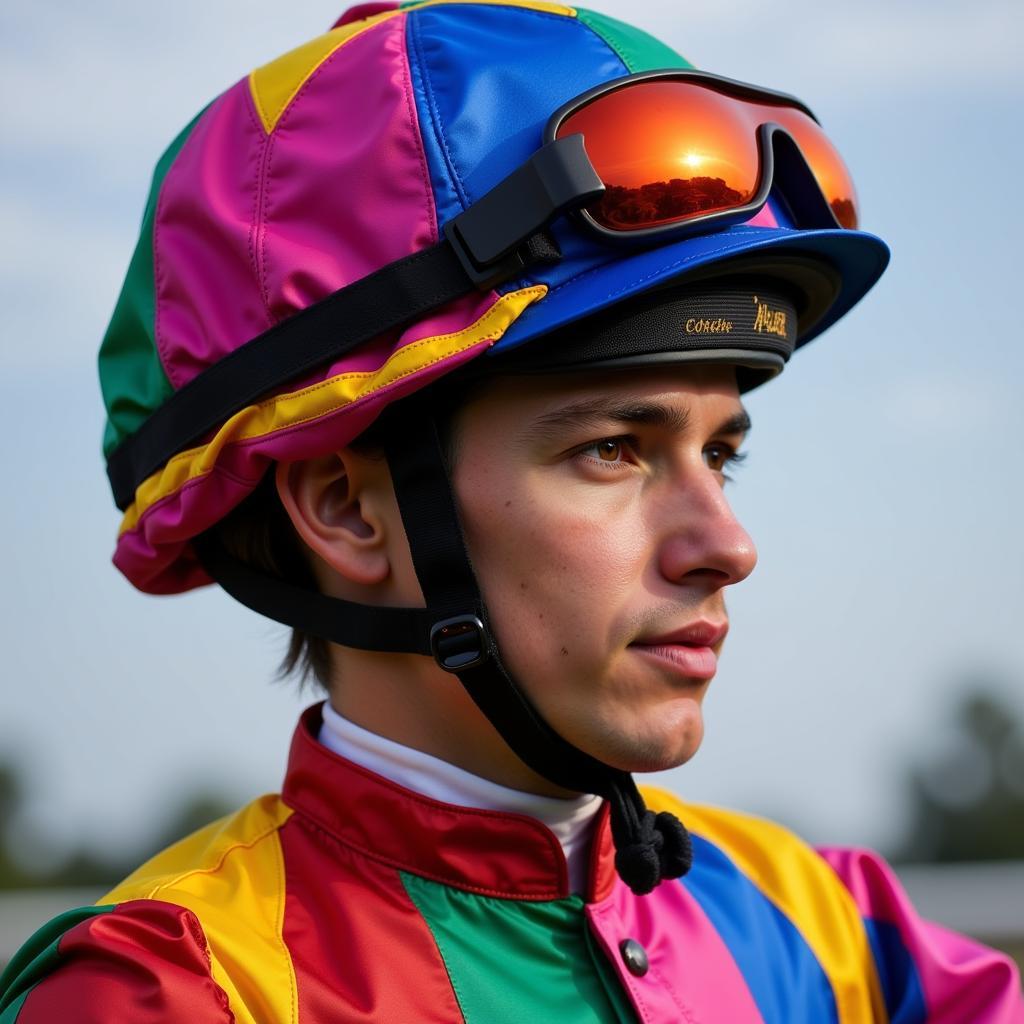Horse racing is a sport steeped in tradition, and that tradition extends to the attire worn by jockeys, trainers, and spectators alike. Whether you’re a seasoned horse racing enthusiast or a first-timer at the track, understanding the nuances of horse racing apparel can enhance your experience. This comprehensive guide delves into the world of horse racing clothing, offering insights into its history, functionality, and style considerations.
 Jockey wearing colorful silks and helmet
Jockey wearing colorful silks and helmet
A Legacy of Tradition and Functionality
Horse racing apparel is more than just clothing; it’s a reflection of the sport’s rich heritage. From the iconic jockey silks to the elegant attire donned by spectators in the Royal Enclosure at Ascot, every garment tells a story.
Jockey Silks: A Tapestry of Color and History
The most recognizable element of horse racing apparel is undoubtedly the jockey silks. These brightly colored jackets, worn over protective gear, serve as a visual representation of the horse’s owner. Each set of silks is unique, registered with racing authorities to prevent duplication.
Historically, silks were made from silk, hence the name. Today, lightweight, breathable synthetic fabrics are preferred for their comfort and performance-enhancing properties.
Beyond the Silks: Essential Jockey Gear
Underneath the vibrant silks, jockeys wear specialized protective gear designed to minimize injury during a race. This includes:
- Helmet: A hard-shell helmet provides crucial head protection.
- Safety Vest: A padded vest worn over the silks offers additional protection to the torso.
- Riding Boots: Knee-high boots with reinforced heels provide ankle support and grip in the stirrups.
- Riding Breeches: Form-fitting breeches allow for freedom of movement while riding.
- Goggles: Protective goggles shield the eyes from debris and wind.
Dressing for the Occasion: Spectator Attire
While jockeys adhere to a strict dress code, spectators have more leeway in their attire. However, many racecourses still maintain dress codes, particularly for specific enclosures or events.
Generally, it’s recommended to dress smartly when attending the races. Men might opt for a suit or tailored trousers with a collared shirt, while women often choose dresses, skirts, or dress pants paired with elegant tops.
Finding the Perfect Fit: Horse Racing Apparel for Every Enthusiast
Whether you’re a jockey, trainer, groom, or passionate spectator, there’s a wide array of horse racing apparel designed to meet your specific needs.
Performance-Driven Gear for Equestrian Athletes
For those actively involved in the sport, comfort, functionality, and safety are paramount. When selecting horse racing apparel, consider the following:
- Breathability: Look for fabrics that wick away moisture and allow for optimal airflow.
- Flexibility: Choose garments that allow for a full range of motion.
- Durability: Horse racing apparel should be able to withstand the rigors of the sport.
Style and Sophistication: Spectator Apparel
For spectators, horse racing offers a chance to showcase personal style. When choosing your outfit, keep the following tips in mind:
- Consider the Dress Code: Adhere to any dress codes specified by the racecourse.
- Dress for the Weather: Check the forecast and choose attire accordingly.
- Accessorize: Hats, jewelry, and bags can elevate your race day look.
Horse Racing Apparel: A Timeless Expression of Tradition and Passion
From the practicality of jockey silks to the elegance of spectator attire, horse racing apparel is a testament to the sport’s enduring legacy. By understanding the history, functionality, and style considerations, you can fully immerse yourself in the exhilarating world of horse racing. Whether you’re cheering from the stands or riding for victory, let your attire reflect your passion for this timeless sport.
FAQs
1. What is the significance of the colors and patterns on jockey silks?
The colors and patterns on jockey silks represent the horse’s owner, allowing spectators to easily identify the horses on the track.
2. Why do jockeys wear helmets?
Helmets are crucial safety gear in horse racing, protecting jockeys from head injuries in the event of a fall.
3. Can I wear jeans to the horse races?
While dress codes vary by racecourse and event, jeans are generally considered too casual for most horse races.
4. What type of shoes are appropriate for horse racing?
Closed-toe shoes, such as flats, wedges, or dress shoes, are recommended for women. Men should opt for dress shoes or loafers. Avoid wearing high heels or open-toe shoes.
5. Are there any specific rules regarding hats at horse races?
Some racecourses, such as Ascot, have strict hat guidelines, particularly for prestigious enclosures. Be sure to check the specific dress code before attending.
Need Help with Your Horse Racing Apparel?
Contact Justus Horses USA at Phone Number: 0772127271, Email: [email protected] or visit us at QGM2+WX2, Vị Trung, Vị Thuỷ, Hậu Giang, Việt Nam. Our dedicated customer support team is available 24/7 to assist you.